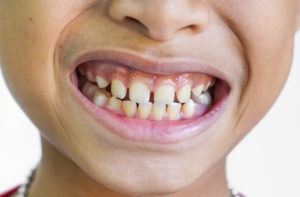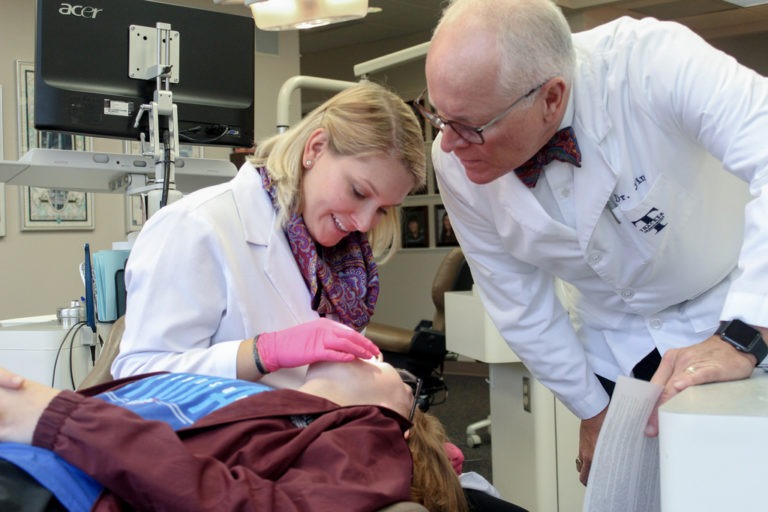As a parent, you have a lot to remember and keep track of. Making sure your child is meeting all their milestones, signing permission slips, picking them up from practice…..it can be hard to juggle everything on your plate! Even so, you’re probably vigilant about scheduling regular dental checkups and making sure everybody brushes their teeth before bed, because you know how important dental care is for your children, starting from an early age. What you may not know is that the American Association of Orthodontists recommends a child have their first orthodontic evaluation by around seven years old. This might be surprising, since most people tend to associate orthodontics with tweens and teens. But children this age still have their baby teeth and a developing mouth, making it an ideal time to introduce orthodontic care.
This kind of preventative care is beneficial in many ways. By having experienced orthodontists like Dr. Jim and Dr. MaryEvan examine your child in their younger years, potential issues can be caught early, before they have the chance to become more serious. This can help prevent any negative impact on their future permanent teeth, and their developing jaws. Here at Thacker Orthodontics, we see many patients from childhood through adolescence. We’ve seen firsthand many time over how diagnosing and treating issues before they become problematic can make a really positive difference to their overall oral health as they grow.
When you schedule a free consultation for your child with us, Dr. Jim or Dr. MaryEvan will perform a comprehensive orthodontic evaluation. During this exam, there are several issues they’ll be looking for. Let’s take a closer look at what you can expect.
Tooth loss and eruption
A child’s primary teeth are placeholders for the permanent ones, and the transition that happens as your child moves from baby to adult teeth is an important one. Our doctors will take careful note of where they are located and when they are lost, since baby teeth normally fall out in a fairly regular pattern. If we find any significant deviation from this pattern, it can be a sign that there may be developmental issues needing attention.
By the age of seven, most children will have at least four permanent molars, and two to four permanent incisors. If your child has more or less than this, it could indicate the potential for missing, crowding, or extra teeth at some point in the future. Sometimes removing a primary tooth early, or maintaining a space where a tooth has been lost prematurely, can help to prevent bigger issues later on.
Crowding and spacing
Experienced orthodontists like Dr. Jim and Dr. MaryEvan are generally able to tell early on in your child’s life if they already have or are likely to have problems in the future with excessive crowding or spacing of their teeth. Spacing issues can show up when a tooth is lost prematurely, where one has never developed, or with teeth that are just too small or spaced apart. When we’re dealing with crowded teeth, we can often expand the arches or remove teeth to create more room as needed.
Misalignment
When the teeth are crooked, they’re more susceptible to damage and wear. If left untreated over time, this can affect the shape and position of the surrounding gum tissue. By correcting crooked teeth at an earlier age, we can help prevent excessive wear and tear and keep the gums from being compromised. An added bonus is that early treatment to correct misalignment will often improve your child’s self-esteem, giving them a more positive self-image during a time when it may be in short supply.
Overbite or protrusive front teeth
While the most visible concern with front teeth that obviously protrude is cosmetic in nature, they can also cause pain in the jaw, and sometimes even speech issues. We may need to wait until your child’s mouth is finished growing before attempting to permanently correct an overbite, but we can often help to reduce the severity of the problem in the meantime.
Underbite
Underbites can be caused by either tooth or jaw problems. In more severe cases, the lower jaw grows too far forward. As with overbites, we will sometimes need to wait until your child has finished growing to finish their treatment for an underbite, which usually occurs by around the age of sixteen. Although there may be a waiting period involved, early treatment remains incredibly important. To avoid issues like bite-shifting and damage to the front teeth, we always try to normalize the bite as much as possible, as early as possible.
If we do notice an underbite in your young child, there’s a treatment option called “jumping the bite”, using braces or headgear. This allows us to get a handle on it before completing treatment in their teenage years. Patients who are treated for an underbite between the ages of about 7-10 are much less likely to need jaw surgery when they are older, proof that early treatment can reduce the risk for more invasive treatment later.
Posterior crossbites
Posterior crossbites can cause crowding in your child’s mouth, and can also cause the jaw to shift from one side to the other. If we catch this early, we have the option to expand the upper jaw around seven to ten years of age. This can reduce crowding and create the kind of space necessary to allow the front teeth to erupt. Expansion can also eliminate any shifting that may be present due to a constricted upper jaw.
Anterior open bites and deep bites
These are vertical problems with the bite, and experienced orthodontists like Dr. Jim and Dr. MaryEvan will normally be able to spot them by the time your child is around 7 years old. In bites that are too deep, the top teeth can completely cover the bottom ones when biting. This can indicate a small lower jaw. Open bites often don’t overlap enough, and may be a sign that there is a finger, thumb, or tongue habit causing dental problems. Whatever the underlying issue, we’ll work with both you and your child to eliminate these kind of destructive habits early on, allowing normal development to occur.
Early evaluations equal easier smiles with Thacker Orthodontics
Early orthodontic evaluations are an important part of giving your child the best chance for a healthy, straight smile, but the benefits don’t stop there! Delaying orthodontic evaluations until there’s a problem noticeable to you can end up costing you more, as well as taking up more of your valuable time.
Missing out on an early evaluation and possible preventative treatment can also lead to more painful treatment later in life for your child. Most children lose all their baby teeth by the time they’re entering their teens, and by the end of those teen years, the jaw bones harden and stop growing. Any orthodontic procedures performed after this point will tend to be more intensive, and can sometimes involve things like tooth extraction or oral surgery. Receiving early orthodontic treatment can help prevent the need for orthodontics as an adult, reducing the need for any extractions or surgery in the future.
Even though some treatments will require all the permanent teeth being erupted before proceeding, early orthodontic evaluations can make comprehensive treatment for your child faster and better. Thacker Orthodontics has a highly trained team, and we are dedicated to providing our patients with the best care possible in a comfortable, stress-free environment. If you’re in the Cincinnati, Hillsboro, or surrounding area, and have a child around seven years old who is ready for their first orthodontic evaluation, give us a call today to schedule a complimentary consultation. Give your child the best start to the healthiest smile by getting in touch with us!


